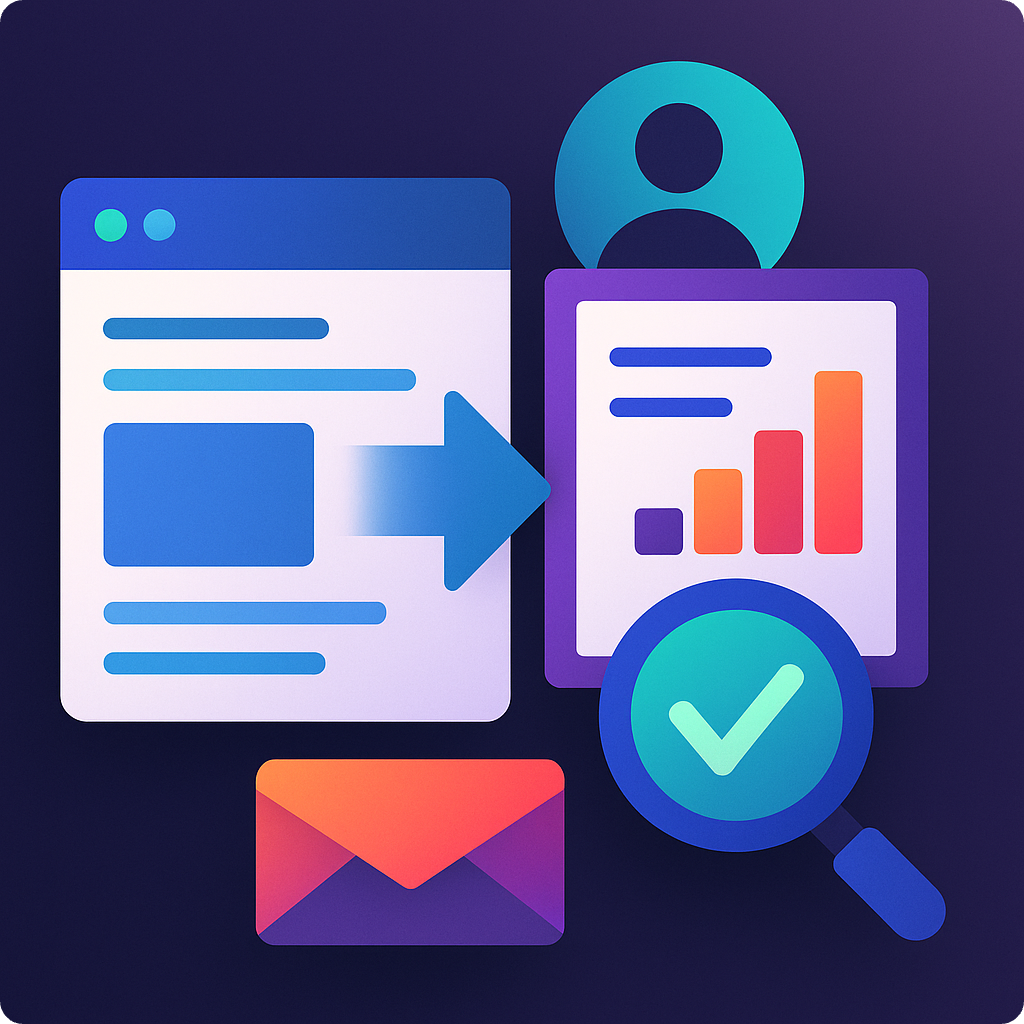How to Use Intent Data Safely Without Compromising Privacy

Intent data (information about a person or company’s online behavior) helps sales teams identify when a potential client is preparing to make a purchase, empowering them to make targeted, well-timed sales outreach.
However, collecting and using behavioral data must be done responsibly, as this sensitive information can compromise an individual's privacy. As such, intent data must always be used in accordance with consumer protection laws, not only to protect clients but also to prevent mismanagement that could lead to heavy regulatory consequences.
Here, I explore how to use intent data effectively while maintaining high standards of privacy, transparency, and security. This is so that you can deliver high-performing results without crossing ethical or legal boundaries.
What Is Intent Data and Why Does It Matter
Intent data shows when a potential customer is actively researching a product or service. It lets sales and marketing teams see which prospects are researching and when they are likely to make a decision for better prospecting.
There are two main types of intent data.
First-party intent data comes from your own platforms. This includes actions like visiting your website, opening emails, or submitting a demo request. Because you collect this data directly, it is usually more accurate and easier to manage from a privacy perspective.
Third-party intent data comes from activity on external websites. This includes reading comparison articles, browsing review sites, or engaging with partner content. These signals are gathered by outside providers and help you find interested buyers who have not interacted with your brand yet.
When used correctly, intent data helps sales teams focus on the right accounts. It improves targeting, supports better timing, and reduces the guesswork in outreach. Instead of chasing cold leads, your team connects with people who are already looking. It also improves customer experience by helping teams tailor communication to each buyer’s needs and stage in the journey. Instead of generic outreach, prospects receive more relevant and timely information.
Where Does Intent Data Come From?

Intent data comes from digital signals that track and record how potential buyers behave online. It’s important for companies that wish to use intent data to know where that information came from for compliance and quality control.
Website Tracking
First-party intent data normally starts on your website with tools like cookies, tracking pixels, and analytics software.
These tools capture which pages someone views, how long they stay on each page, and what actions they take, all key insights that show how prepared a potential client is to make a purchase.
Content Engagement
Downloads, webinar attendance, and time spent reading specific articles all signal deeper interest. If someone signs up for a webinar or reads a product comparison guide, they are likely exploring a solution. Tracking these actions helps you identify leads who may be ready to engage.
Third-Party Providers
There are services that monitor user behaviour over multiple websites and aggregate this information into a big-picture image of the target’s behavior.
It is your responsibility to work with only reputable third-party providers, and to use the information they collect ethically and safely.
Public Sources
Online activity on social platforms, such as LinkedIn, community forums like Reddit and Quora, review websites, or even call analytics, are also very strong indicators of intent.
For instance, if someone posts in Reddit “which cybersecurity software have you guys had the best results with?”, that clearly indicates that the individual is considering investing in cybersecurity.
Tracking these public sources and knowing who is looking for what can give companies a good opportunity for outreach.
What Makes Intent Data Risky for Privacy
While intent data undoubtedly enhances sales strategy and improves lead targeting, it brings real privacy concerns.
Depending on the source and collection method, intent data often includes highly sensitive information, such as:
- Names, job titles, company details, or email addresses
- Device IDs, IP addresses, or cookie IDs that can trace behavior back to a specific person
If this kind of information isn’t anonymized or secured, it can expose individuals or companies to privacy violations, compliance breaches, or competitive intelligence risks.
In many cases, these risks are aggravated by the following:
Over-collecting data
One common mistake companies make is gathering more information than needed.
In such cases, sales teams collect sensitive personal details that serve no real purpose in outreach but can compromise users' privacy. Not only is this unethical, but it unnecessarily increases the chance of non-compliance with data protection laws.
Lack of transparency
User consent and awareness are the first steps in compliance and ethical data collection. Many users do not know their online activity is being tracked, and as such, it falls to the company and website to notify them that their behavior is being monitored and offer them the chance to opt in or out.
Data breaches
Lead databases are frequent targets for cyberattacks.
If intent data is not stored securely, it can be stolen or leaked, putting prospects and businesses at risk. Poor access controls or outdated security practices increase these risks. CCPA requires businesses to handle user data with care and have strict rules on how personal information can be collected, processed, and stored.
Collecting intent data without proper consent, failing to inform users, or keeping data longer than necessary can violate these regulations and result in large fines or legal consequences. Even if the data is helpful, improper handling or noncompliance creates significant legal risk.
To benefit from intent data without problems, build privacy safeguards into every part of your process. The following best practices will help you collect only what’s necessary, store it securely, and stay transparent with the people behind the data.
7 Best Practices for Using Intent Data Safely

We strongly suggest using intent data in your sales strategies, but only if used correctly. Follow these 7 steps to ensure you’re using intent data safely and in accordance with laws and regulations in the jurisdictions you operate in.
1. Collect Intent Data from Trusted Sources Only
ONLY use verified, reputable third-party data providers that disclose how they obtain their data.
As we discussed, unverified sellers compromise accuracy, compliance, and reputation.
For example, Skrapp.io follows compliant methods that guarantee data accuracy and integrity. Relying on trusted providers, such as Skrapp.io, eliminates unnecessary risk and ensures consistent reliability.
2. Collect Only What’s Necessary
Only collect data that is absolutely necessary for your sales strategy - be it improving customer experience, managing the customer journey more effectively, refining outreach efforts, or personalizing offers.
Every unnecessary field adds risk and complexity, so eliminate any data field that doesn’t serve a direct purpose in your lead generation funnel.
3. Stay Compliant with Regulations (GDPR, CCPA, and Others)
Compliance is non-negotiable. Confirm that every intent data provider adheres to frameworks like GDPR and CCPA. Your own processes must meet those same standards.
Implement explicit consent procedures, honor opt-outs immediately, and document every compliance step.
4. Anonymize and Secure Your Data Storage
Remove all personal identifiers whenever possible. Anonymization preserves privacy while maintaining insight accuracy, and compromised personal identifiers are some of the main causes of identity theft online. Using identity theft protection can further help secure sensitive information.
Furthermore, encrypt data while it is both at rest and in transit. Restrict access to authorized personnel only. Conduct regular security audits and patch vulnerabilities immediately. While these are rudimentary actions, it’s important to confirm you acknowledge them in your own cybersecurity framework.
5. Gain Consent and Communicate Transparency with Prospects
Be transparent about how you use intent data with your clients. Not only will this help establish a foundation of trust between you and your clientele, but it will also ensure compliance with privacy laws.
Do this by including a direct statement in your outreach, such as: “We use general buying signals, not personal data, to keep our communication relevant and respectful.”
Another consideration is to encourage your clients to review their online digital footprints with tools like Aura. Doing so builds awareness around how online behavioral data is collected and used, and fosters communication and trust between you and your clients.
6. Regularly Audit Your Sales and Marketing Tools
Third-party suppliers pose significant threats to your organization and its data. As such, treat every platform in your tech stack as a potential risk until verified.
Only use systems with robust security and clear data handling policies. Importantly, remove any tool that exposes your leads to third parties without explicit consent.
7. Train Your Team
A trained team prevents errors before they happen. Every sales rep and BDR must understand privacy fundamentals and follow them without exception.
You need to go beyond a one-time onboarding. Think of hosting webinars regularly, running interactive workshops, and sharing quick refresher sessions to keep privacy best practices top of your team's mind.
Train your team to secure data, use compliant outreach practices, and handle consent questions confidently. Knowledgeable employees are your strongest defense against data misuse.
What Does This All Mean for You?
Intent data can transform how your sales team identifies and approaches potential buyers. It reveals who is actively researching, where their interests lie, and when they are most likely to engage. But with this insight comes responsibility. You are responsible for this data and how you use it.
To use intent data effectively and ethically, focus on quality over quantity. Work only with trusted sources, collect the minimum data you need, and stay transparent about your practices. Keep your systems secure, comply with all regulations, and ensure your team is trained to handle data with care. To use intent data effectively, consider partnering with a secure platform like Skrapp.io.
We help you enrich your pipeline with accurate, compliant data—so you can reach the right people at the right time, without compromising their privacy.
FAQs: Intent Data Safety
What is an example of intent data?
A visitor who downloads a product comparison guide or repeatedly views a pricing page signals buying intent. These actions are tracked and categorized as intent data
What is intent used for?
Intent helps identify prospects actively researching a solution, allowing sales and marketing teams to focus outreach on high-interest leads.
How to collect intent data?
You can collect intent data through website analytics, form submissions, email engagement, or by using third-party platforms that track behavior across the web.
What is an example of an intent?
Searching for “best CRM for small business” or signing up for a software demo both indicate intent to explore or purchase a solution.
How to calculate intent?
Intent is often scored using a combination of behavioral signals, such as content views, click frequency, and engagement duration. Higher scores suggest stronger interest or readiness to buy.
